Ask Ethan: an excess of positrons - is it worth to ascribe the solution of all the mysteries of astrophysics to dark matter?
- Transfer

The HAWC telescope with a wide field of view sees the Geminga pulsars and PSR B0656 + 14 as beacons of gamma radiation, the angular size of which is larger than that of the Moon (it is given for scale).
Despite all our knowledge of the laws of physics and the successes of the Standard Model and the General Theory of Relativity, some observations of phenomena in the Universe lack a comprehensive explanation. The universe is still full of mysteries, from the formation of stars to high-energy cosmic rays. Although we have made many discoveries related to space, we still do not know everything. Does this mean that it is necessary to attribute any unknown effect to the action of dark matter? Our reader asks:
About dark matter is usually written that it does not interact with matter, except through gravity. So how to find it? It looks like an old riddle with black holes sucking everything around. And then I read in another article that it can be detected by other means, and not only through gravitational lensing. How does its annihilation happen? Does it look like positron annihilation with electrons?
It lists a lot of mysteries and a lot of evidence of dark matter. But attributing to the work of TM all riddles is not only a myopic approach, but also an excellent example of demonstrating what happens when scientists run out of good ideas.

Each of the two bright large galaxies in the center of the Veronica Volos cluster , NGC 4889 (left) and NGC 4874 (right, slightly smaller in size), is more than a million light-years. But the rapid movement of galaxies located on the periphery indicates the presence of a large halo of dark matter throughout the entire cluster.
Dark matter is scattered throughout the universe. Its concept was first proposed in the 1930s to explain the fast movement of individual galaxies in clusters, since it turned out that all normal matter — consisting of protons, neutrons, and electrons — is not enough to explain the total amount of gravity. These are stars, planets, gas, dust, interstellar and intergalactic plasma, black holes and everything that we can measure. In support of dark matter says a lot of convincing factors.

The cosmic network is controlled by dark matter, and the structures of the largest scales are determined by the speed of expansion and dark energy. Small structures located along the filaments are formed due to the collapse of normal matter that interacts electromagnetically.
And this includes not only galaxies in clusters, although each cluster definitely needs this. TM is required for:
- descriptions of the rotation properties of galaxies,
- the formation of galaxies of various sizes, from giant elliptical galaxies the size of the Milky Way to tiny dwarf,
- interactions between pairs of galaxies,
- galaxy clustering properties and large-scale galactic clusters,
- space network, including its filiform structure,
- fluctuation spectrum of the background radiation,
- the observed effects of gravitational lensing on remote masses,
- the difference between the observed effects of gravity and that present in the colliding galactic clusters of normal matter.
Dark matter is entirely necessary from the small scales of individual galaxies to the Universe.
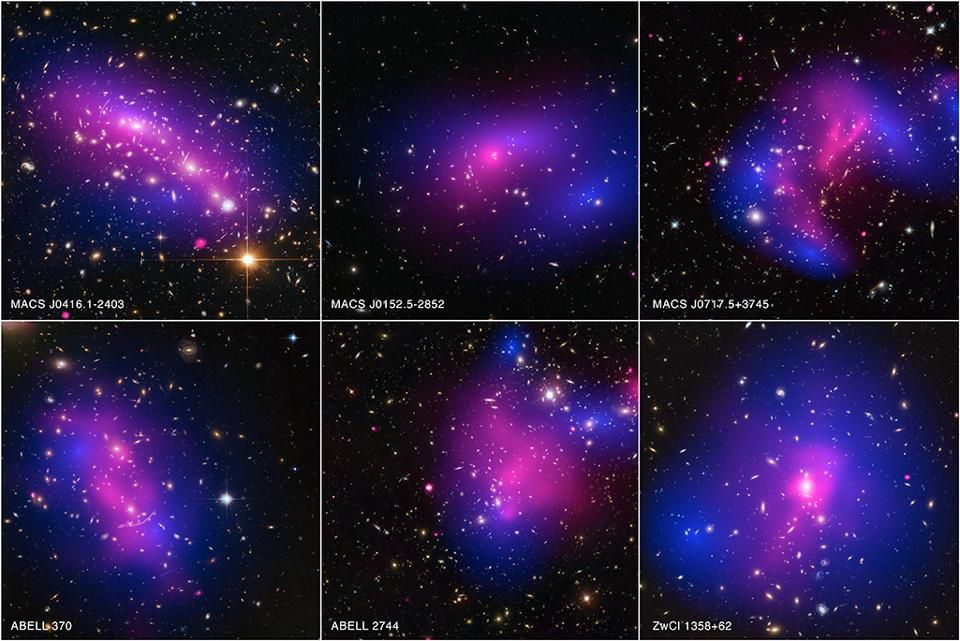
X-ray (pink) and general maps of matter (blue) of various colliding galactic clusters demonstrate the difference between normal matter and gravitational effects - this is one of the most convincing evidence of dark matter. Alternative theories of gravity have to become so tight that many find them ridiculous.
If we combine this with the rest of cosmology, we will get evidence that every galaxy, including ours, contains a massive sparse halo of its surrounding TM. Unlike stars, gas and dust in galaxies that exist in the form of a disk, the TM halo must be spherical, since there is a lot of evidence that TM, unlike normal, atom-based matter, does not flatten when colliding with itself or with ordinary matter. Moreover, the TM should be the most dense around the center of the galaxy, and decrease in density with distance, and also extend, probably, at a distance of ten times greater than the distribution of stars. Finally, in each halo there should be small lumps of TM.

In accordance with models and simulations, all galaxies should be surrounded by dark matter halos with a density peak in the galactic center. However, unless TM obeys certain models and has specific properties, it will be difficult
to explain an excess of positrons or gamma rays. To explain the entire spectrum of the above observations and several others, TM should not have any other properties than the following:
- she must have weight;
- it must interact gravitationally;
- it should move slowly relative to the speed of light from the earliest times;
- she practically should not experience other types of interactions.
That's all. All other interactions are strictly limited, but not excluded.
So why, every time when an astrophysical observation of an excess of some kind of normal particles - photons, positrons, antiprotons, etc. occurs? - do people first of all seek to “blame” TM?

If you do not know how to explain the observations, not related to gravity, immediately blame all of TM - then grab a straw.
In November 2017, a team that studied gamma radiation sources near pulsars published their work in the journal Science, and tried to better understand where the observed excess positrons come from. Positrons, antiparticles of electrons, naturally appear when particles of normal matter are accelerated to sufficiently high energies, as a result of which electron-positron pairs can appear in collisions based on Einstein's E = mc 2 . In particle physics experiments, we create these pairs on a routine basis, and we can also see evidence of the creation of positrons in astrophysics — either directly, when searching for cosmic rays, or indirectly, by studying the energy signs of electron-positron rescanniation.
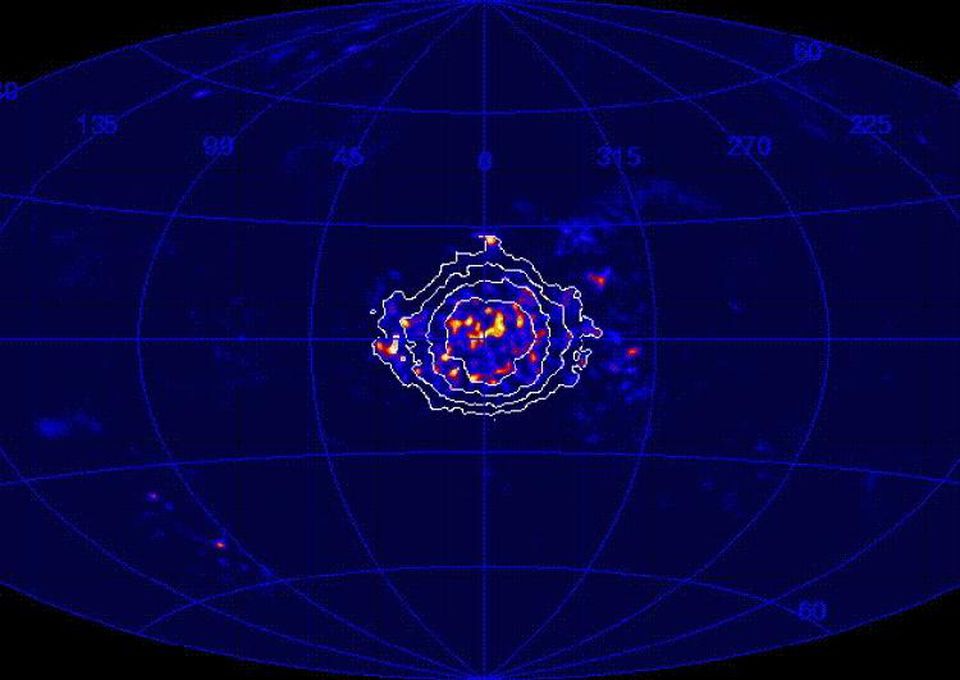
Characteristic signals for electron-positron re-annihilation at low energies, on the photon line at 511 keV, were comprehensively measured by the INTEGRAL satellite
Astrophysical signs of the presence of positrons are visible around the center of the Galaxy, they are concentrated around point sources like microquasars and pulsars located in the mysterious region of our Galaxy called the " great annihilator ", and are observed as a scattered background of unknown origin. One thing is clear: in general, we see more positrons than one would expect. This has been known for years: as a result of measurements of PAMELA , Fermi , magnetic alpha spectrometer onboard the ISS. Recently, the HAWC observatorymeasured very high energy gamma rays of the order of TeV, which means that very overclocked particles come to us from the direction of middle-aged pulsars. But, unfortunately, this is not enough to explain the excess positrons.
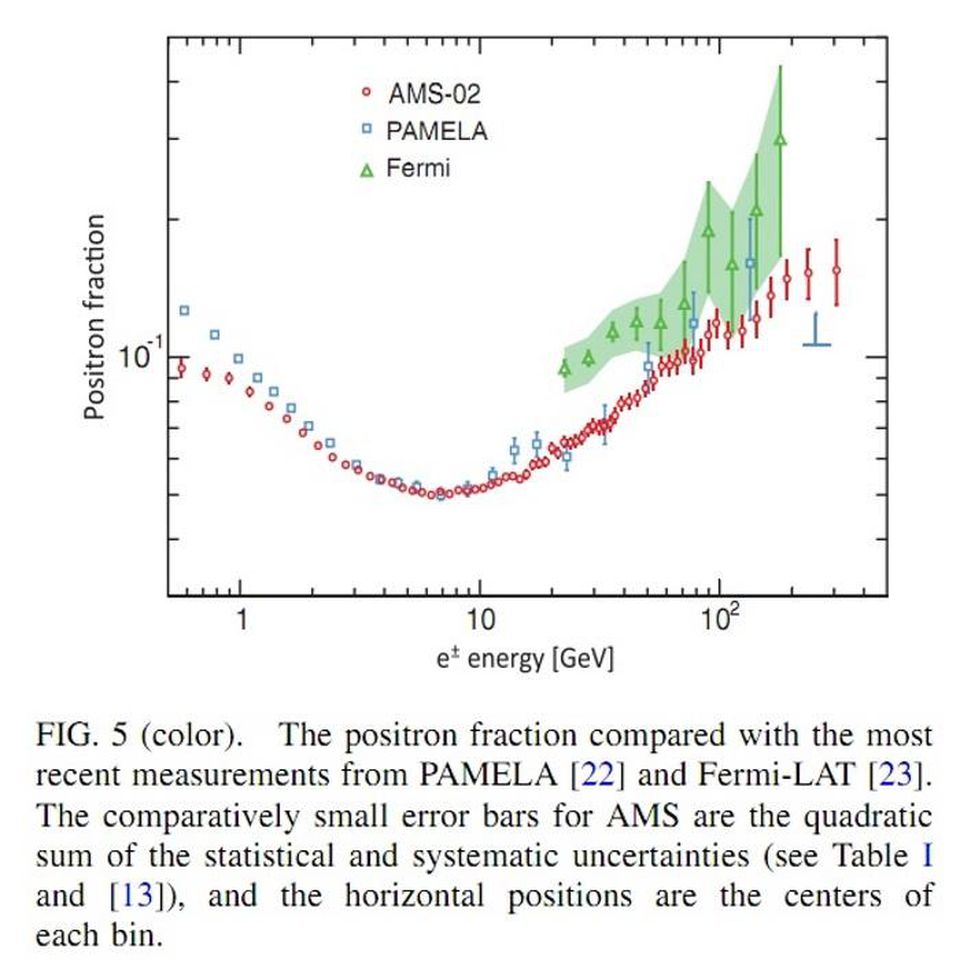
An excess of high-energy positrons is difficult to explain, but the lack of straightening of the spectrum graph, continued by measuring HAWC, is against the dark matter,
but for some reason, with each new measurement of excess positrons or by observing an astrophysical source that cannot to respond, immediately begin conversations in the style of "we can not explain it, so dark matter is to blame for everything." And this is bad - there are quite a few candidates for astrophysical sources that do not require any exotic:
- secondary production of positrons and gamma rays on other particles,
- microquasars or other black holes absorbing matter,
- very young or very old pulsars, including magnetars,
- supernova remnants.
And this is not a complete list - just examples of what might be causing this excess.
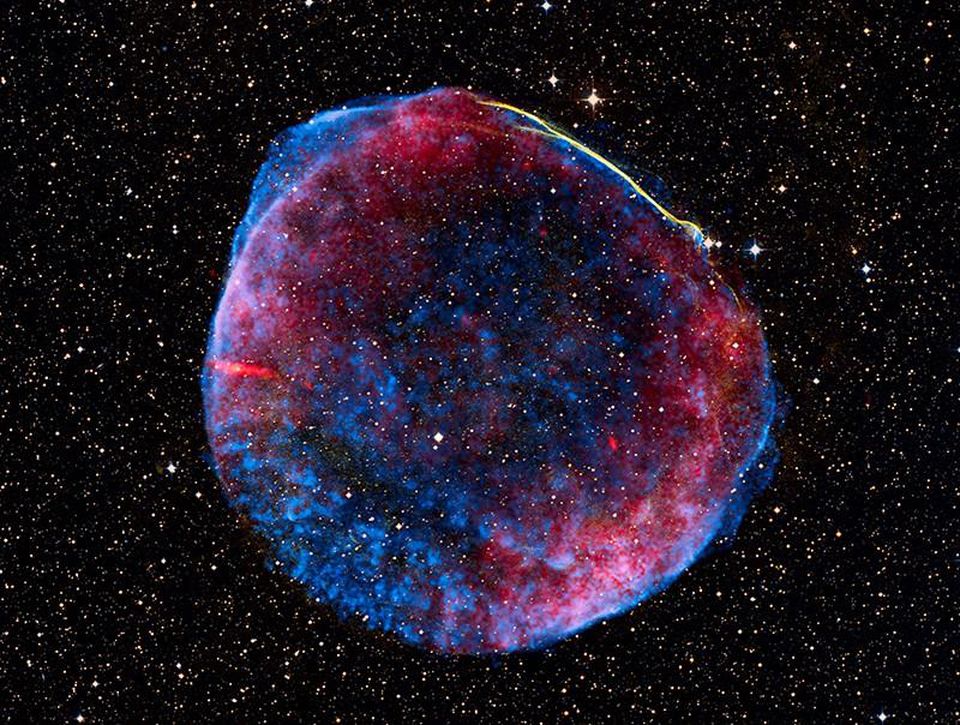
Supernova remnants do not just throw heavy elements back into the Universe created by the explosion - the presence of these elements can be determined from the Earth
Many scientists working in this area tend to dark matter mainly because if it annihilated and generated gamma rays and particles normal matter, it would be a revolution and a breakthrough. It would be ideal for dark matter hunters among astrophysicists. But wishful thinking does not work, and, as far as we can judge, the annihilation of dark matter particles is still not detected by us. And although TM is always distinguished as a possible explanation for the excess positrons, this is no more likely option thanAlien activity in the case of the star Tabbi .
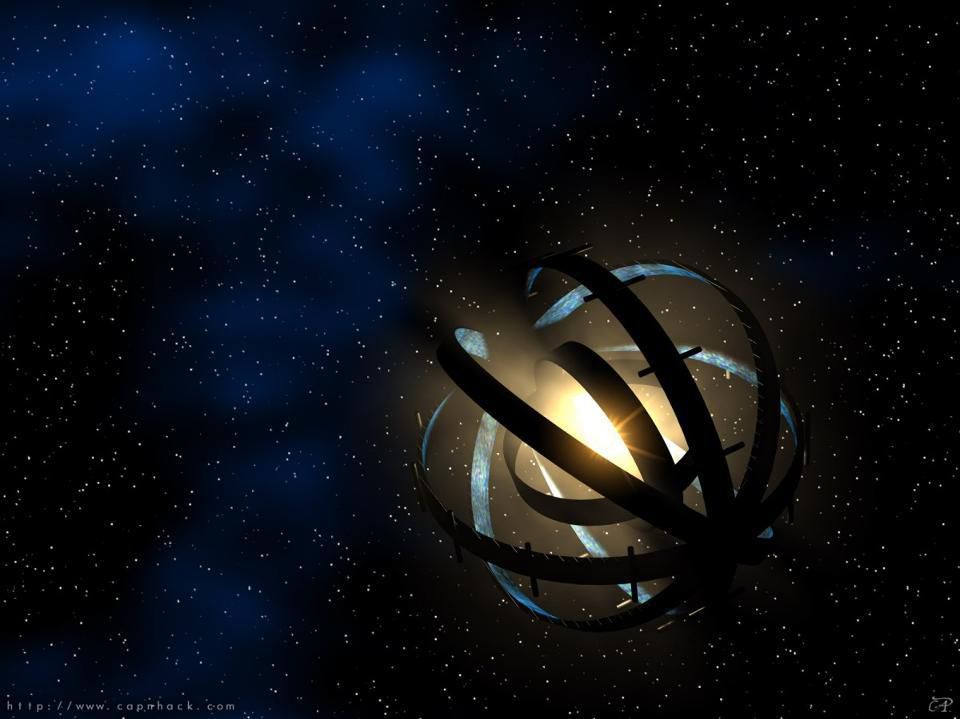
The idea of enclosing a star from a light-gathering material is known as the Dyson Sphere. During construction, it can cover more and more starlight. This is an unlikely explanation of the activity of the star Tabbi is similar to the explanation of the excess positrons using TM.
I contacted Brenda Dingus, the research manager of the HAWC project, and she commented on it this way:
There is no doubt that positrons have other sources. However, positrons do not spread far from sources and sources of positrons nearby are not that many. The two best candidates for sources were discovered by HAWC, and now we know the number of positrons they give out. And we also know how these positrons are scattered from sources, and this happens more slowly than previously thought. Consequently, although we confirmed the presence of nearby positron sources, we found that positrons very slowly propagate from the source, and therefore are not responsible for the excess positrons found on Earth.
When you cross out one opportunity, it increases the likelihood of the others. However, this does not mean that these positrons necessarily come from dark matter. We did not have this in mind.

The estimated positron surplus in HAWC observations suggests that only a small fraction of the required number of positrons could come from sources such as closely spaced middle-aged pulsars.
The fact that the data from HAWC explain the presence of only 1% of the positrons observed in other experiments is indeed true, and this is quite remarkable - and says that something else is to blame for their presence. When you have an observation that cannot be explained by ordinary ideas, for example, an excess of astrophysical positrons, you can put forward the idea that this TM demonstrates long-sought interactions. But it is much more likely that some other astrophysical process accelerates known, ordinary particles, which leads to such effects. When a mystery appears in science, it is necessary to keep the mind open for the possibility of revolution, but to rely on the ordinary. And never believe the hype stating the opposite.
